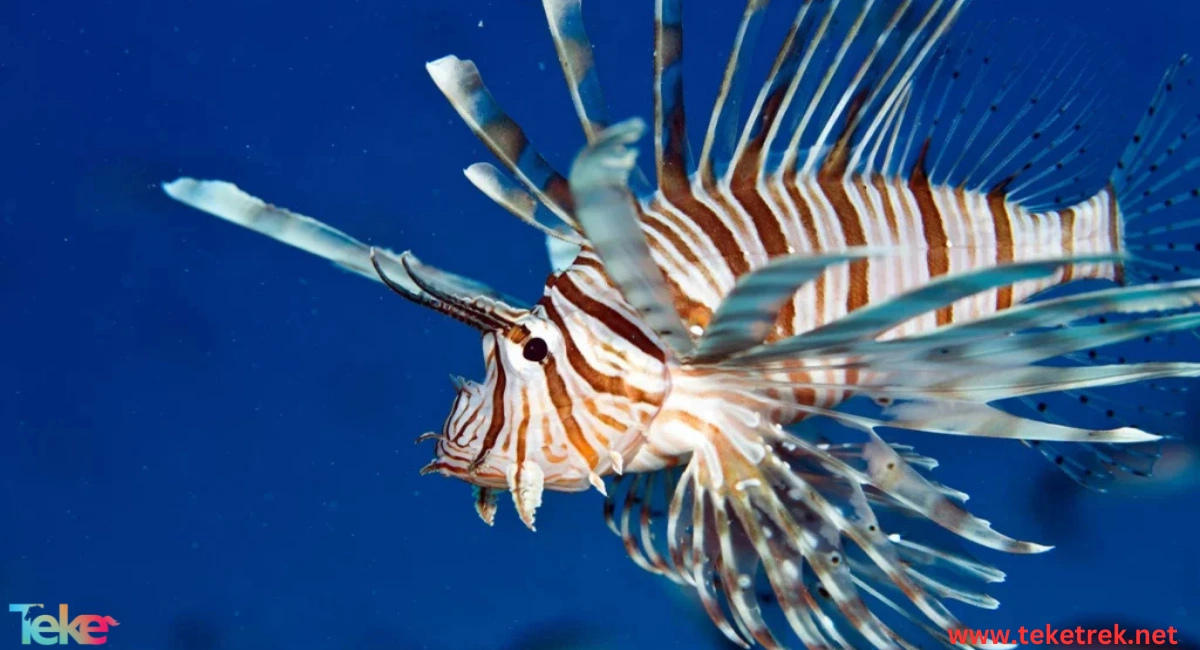The Chicken sea fish is known by many names such as the Lionfish, Firefish, or Red Dragonfish.
Scientifically, it is called Pterois volitans
.Let’s learn more about it from teketrek.

facts about The Chicken Sea fish:
It is considered a venomous predatory fish that causes harm to marine environments, especially coral reefs.
The Chicken sea fish belongs to the phylum Chordata within vertebrate animals.
It is classified as a fish with spines and fins, and it is one of the venomous fish species.
The most important behavioral characteristics that distinguish the Chicken sea fish from other fish species:
The Chicken sea fish has a unique hunting strategy.
It moves slowly towards its prey and then swiftly strikes and attacks.
Lionfish use coral reefs and rocks as habitats, preferring to be in crevices, edges, and underwater caves.
When in their habitats, Lionfish maintain a stationary position, slightly tilting their heads downwards.
They have the ability to exhibit indifference to threats around them, especially predatory animals in the coral reef environment.
Description of lionfish
Lionfish size: The Chicken sea fish has a relatively medium-sized body, reaching up to about 38 cm in size.
Fins: It has long and colorful fins, with spines containing venom inside them.
The fins are used as a defensive mechanism to protect itself from enemies and predators.
The fins are used to trap prey before consuming it.
The Chicken sea fish has spots on its fins in the dorsal, tail, and anal areas.
Eyes: It has large and distinctive eyes, with structures above its eyes.
The mouth: The mouth of the Chicken sea fish has flexible jaws, aiding in capturing and swallowing prey.
Where can the Chicken sea fish be found?
The Chicken sea fish is found in the Pacific Ocean and the Indian Ocean, which are considered its native habitats.
It can be found in Western Australia and Eastern Malaysia, all the way to France and the United Kingdom.
Chicken sea fish have also been found in Japan and South Korea.
They have been found on the coasts of the United States as well.
What is the Lionfish diet?
The Chicken sea fish primarily feeds on invertebrates, mollusks, and small fish.
Their feeding method involves swallowing prey whole and feeding on them throughout the day and night.
This feeding behavior can be harmful to marine environments and ecosystems.
This type of fish eats anything that crosses its path, with prey sometimes reaching half its size.
Some of the important marine animals that the Chicken sea fish feeds on include octopus, jellyfish, sea worms, sea urchins, parrotfish, and sand divers.
Reproductive stages of the Chicken sea fish:
The mating process in Chicken sea fish occurs between a male and a female before dark.
The male performs courtship movements, including approaching the female, using her pectoral fins for support, circling her, and ascending and descending above the water multiple times.
Afterward, the male and female release eggs and sperm into mucous tubes for fertilization.
After about 12 hours of fertilization, the young Chicken sea fish begin to form, with the head and eyes growing after about 18 hours.
The eggs hatch after about 36 hours, and larvae capable of swimming and feeding independently appear.
Female Chicken sea fish can release approximately 2,000 to 15,000 eggs every four days.
They reproduce year-round, with changes in the fish’s body during mating season.
For example:
The color of male Chicken sea fish becomes darker, and the lines on its body become less distinct.
The females become paler, with their bellies, mouths, and throats turning white or silver.

Important steps to follow when stung by a Chicken sea fish:
Remove the venomous spines from the skin.
Use water and soap to wash the area affected by the sting.
If there is bleeding, apply pressure to stop it.
FAQs about lionfish
What is another name for lionfish?
Members of the genus *Pterois* are collectively known as lionfish, turkeyfish, and firefish.
?What order is a lionfish in
The red lionfish (*Pterois volitans*) is a venomous coral reef fish belonging to the family Scorpaenidae, within the order Scorpaeniformes..
Is lionfish poisonous?
Lionfish are venomous, not poisonous.Venom must be injected into the body through bites, spines, fangs, or stingers for the toxin to take effect, whereas poison must be inhaled, ingested (eaten, swallowed), or absorbed for it to have an impact.
Can other fish eat lionfish?
Of the known species to feed on lionfish in their native Indo-Pacific habitat, predators include moray eels, tiger groupers, and blue-spotted cornet fish. Sharks are also known to prey on lionfish, and it’s believed they’re immune to their venom.
Is it safe to touch lionfish?
For those who keep lionfish as pets, it’s important to be cautious while cleaning the tank. Always be aware of their location, wear gloves, and keep your hands well away from their spines. Avoid touching or handling lionfish, as even a dead lionfish can still sting. If you plan to swim or dive in areas where lionfish are present, wear protective clothing to prevent stings.
Can lionfish be safely eaten?
Yes, it can be eaten, removing the thorns.
In conclusion, it is important to note that this type of fish is very dangerous to human.
The sting of a Chicken sea fish can cause symptoms such as nausea, difficulty breathing, swelling, bruising, and redness at the sting site due to the toxic substances in its spines.
References:
Wikipedia






In the forces no citizen Mironov reporting that Meresjev guy I got out